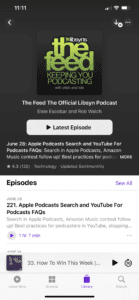Every time you publish an episode, you write an episode description to go with it. These descriptions can be full of exciting details and extra resources, or simple and streamlined.
Regardless of your approach, the content is specific to the episode and the first few lines should be written to attract new audiences.
Check out this screenshot to see exactly how much of the episode description is visible in the directory listing and where it truncates.
Focus your attention on the first few lines of your episode description and don’t repeat your show title — you only have a few lines to grab your audience’s attention. If you’re interviewing someone famous, this is the place to name drop!
Click on the episode and the entire episode description becomes visible.
Episode descriptions are also known as “show notes.” They include time codes listing content and topics that listeners can jump to for a customized listening experience.
Ask Yourself
What do I usually want to know when listening to a podcast episode?
- The name of the interviewed expert
- Links to books or products referenced
- How to ask the podcaster a question about some topic discussed
- Where I can connect with other people who listen
The great part about including these elements in your description is that you don’t have to memorize them for the recording — you can simply say, “Links will be in the description,” and move on!
As you can see in the following screenshot, links to important information and CTA’s are also included in the episode descriptions.
A good starting point for your episode description is to include these elements:
- Super-charged 2 to 5 lines of copy describing the episode content — at the beginning.
- Podcast CTAs — Any links to show-related requests like audio feedback, newsletter signup, or social.
- Sponsor CTAs — Links to sponsor landing pages or products.
- Links to Access — List of links to access your content on the most popular podcast apps.
- Source/Reference Links — When including data from a study or another podcaster, be sure to give them a proper credit.
- Topic Timestamps — These are especially helpful if your content is long and covers many topics.
The Beauty of Snippets!
This may seem like a lot for each episode, but Libsyn makes it easy with unlimited text snippets included in every plan. These let you store the most frequently used elements of your description and use them over and over.
At Libsyn, we are always working to make sure your workflow is as streamlined as possible. Our text snippets are just one of the ways we make publishing your content both easy and exciting (it’s kind of fun). Now, you can spend your time focusing on content, and isn’t that what every creator wants?




